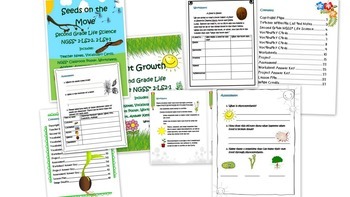Second Grade Life Science Bundle
- Zip
Products in this Bundle (2)
Also included in
- This bundle of eight lessons is compatible with ALL of the Second Grade Next Generation Science Standards* for the ENTIRE YEAR! It is also compatible with 7 CCSS Math standards!The bundle is specially priced at 10% off!!!In these lessons, students will learn about physical science concepts, such asPrice $29.43Original Price $32.70Save $3.27
- This curriculum bundle of TWENTY-SIX lessons covers ALL of the Kindergarten through Second Grade Next Generation Science Standards* including the K-2 Engineering and Design Standards!All of your early elementary science planning is completed for you with these NGSS* aligned lessons. There are alsoPrice $83.61Original Price $92.90Save $9.29
Description
This bundle of two lessons is compatible with ALL of the Second Grade Next Generation Science Standards* for Life Science.
The bundle is specially priced at 10% off!!!
In these lessons, students will learn about life science concepts, such as plant growth, experimentation, recording and analyzing data, controls and variables, biodiversity among plant species, seeds dispersal, ecological resources and competition for those resources, and so much more!
Here is what’s included in EACH of the TWO lessons:
-Teacher notes and materials list
-Next Generation Science Standards* “I can…” and “I understand…” classroom poster
-Vocabulary cards covering the topics of the lesson
-Worksheet(s) covering the lesson objectives
-Hands-on activity
-Supplemental blog posts explaining the hands-on activity in detail on my website Curious Little Classroom!!!
-An assessment covering the lesson objectives
-Answer keys for worksheets, activity, and assessment
-A comprehensive lesson plan including:
Title, Grade, Objectives, NGSS*, Materials Needed, Connections to Real Life, Connections Across the Curriculum, Anticipated Difficulties with the Content, Pre-Requisite Knowledge, Key Vocabulary, Lesson Delivery Method, Examples for Better Understanding, Assessment, Wrap Up and Review, Extensions, and Modifications.
Click the links below for more information on each lesson included in this bundle, including ***PREVIEWS*** and more in depth descriptions.
This lesson is compatible with the Second Grade Next Generation Science Standard* 2-LS2-1 which states that the student should “[p]lan and conduct an investigation to determine if plants need sunlight and water to grow, test one variable at a time.”
This Second Grade Life Science Plant Growth lesson is a great way to get your students to learn how to record scientific data and also appreciate where food comes from. The worksheets introduce the students to the concept of photosynthesis. The hands-on project examines photosynthesis even further by testing whether or not plants need water and sunlight to survive.
This lesson is compatible with the 2nd Grade Next Generation Science Standards* 2-LS2-2 and 2-LS4-1, which states that the student will “[d]evelop a simple model that mimics the function of an animal in dispersing seeds or pollinating plants.”
The student will also “[m]ake observations of plants and animals to compare the diversity of life in different habitats.”
This lesson teaches students about biodiversity and adaptations through the study of different types of plant seeds. It begins with an introduction to seeds through a book study, it then discusses the ecology of seeds and examines the variety of seed dispersal methods.
For the first part of the project, students will sort a collection of real seeds and pictures of seeds based on their dispersal methods. They will then move on to complete an Internet study on the diversity and ecology of 9 different types of seeds.
The next part of the hands-on project is all about seed model making. The students will make their own parachutes, helicopters, poppers, as well as examine Velcro up close to see how it is similar to some seeds.
The lesson ends in an assessment and review of the objectives.
These lessons can be used in a general education or special education classroom, in a home school setting, or as an enrichment experience.
Source:
NGSS Lead States. 2013. Next Generation Science Standards: For States, By States. Washington, DC: The National Academies Press.
*"Next Generation Science Standards (NGSS) is a registered trademark of Achieve. Neither Achieve nor the lead states and partners that developed the Next Generation Science Standards were involved in the production of this product, and do not endorse it.”
.................................................................................................
Curious Little Classroom Loves Their Customers!
Be sure to follow my store to keep up with our newest posts!
CLICK HERE to visit my website for FREE lessons, activities, and more!
If you found value in this product, please leave positive feedback and reviews!
If you have questions or problems please contact me through Product Q & A and I'll get right back to you!
Thank you so much for your support!




